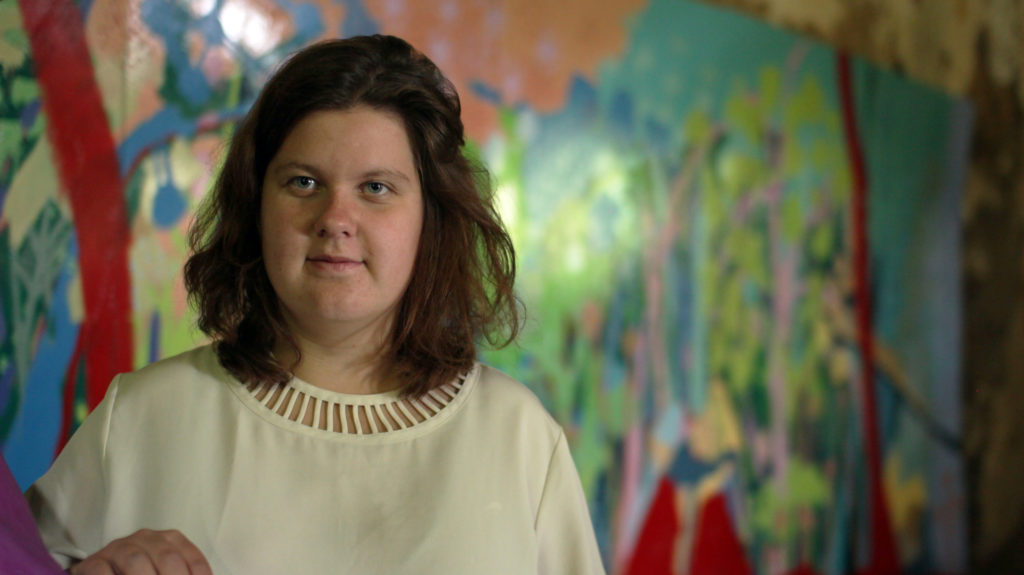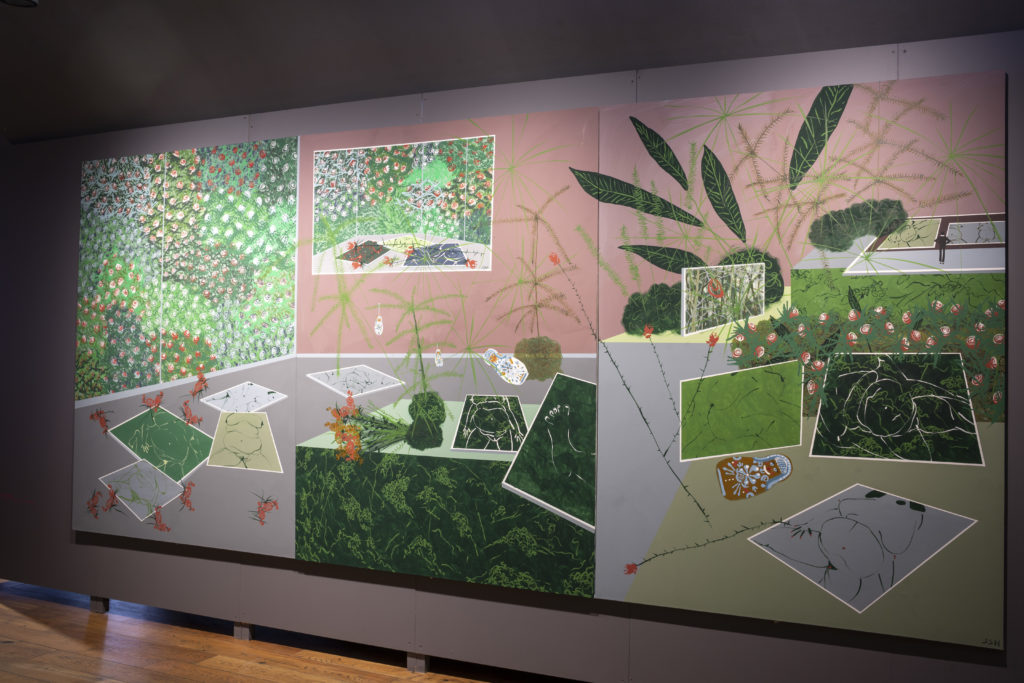Hallway talks with Sandra Strēle (Latvia)

Rothko Centre: You have an impressive track record for such a young artist – exhibitions, residencies, awards… You’re totally focused on art, is that right?
Sandra Strele: Yes, one way or another, it’s my primary occupation. I also teach painting at school, but not much, two days a week. The rest of my time goes entirely to painting – I start in the morning and work all day until evening.
RC: Is your family artistic? Does anyone paint?
SS: No, we have no artists in the family. But my folks have always supported me. That said, they never thought it could become my livelihood. That I could choose it as a profession. In fact, I went to the Rīga State Gymnasium No. 1, and they really focus on mathematics. But somewhere around year 10, I decided I wanted to go to the Art Academy of Latvia.
RC: And how about now? Does math help?
SS: You know, it actually does! Math helps me structure my art. It’s no secret that artists tend to be disorganised. But math helps me keep the deadlines. So the school gave me priceless experience and skills, I mean the ability to structure and organise my work.
RC: Do you switch between art and other things? Or is creativity both business and pleasure?
SS: Of course, painting is work and also something I simply enjoy doing. I can work without taking days off. Especially before exhibitions. But if we’re talking what I do besides studio work, I’d say swimming. I love it. Maybe that’s why I’ve painted swimming pools (laughs).
RC: How do you make lists of your upcoming exhibitions and symposia? Have you already reached the point where you can be selective?
SS: Yes, I’m there now. At this point, I simply don’t have enough time for everything. So I have to set my priorities. Now I’m focusing on solo exhibitions. I prefer to work on my own and do fewer group projects. In my solo shows, I work from the dimensions of the space. That’s an important caveat because I paint on a large scale.
RC: Pair work always means compromise and, in a sense, fear of losing oneself. Can you comment on your cooperation in the Mycelia project now on show at the Rothko Centre?
SS: Yes, pair work is an exciting experience, but I prefer going solo. Really successful cooperations, when both artists have done their best, with an almost perfect result for both, are extremely rare.
RC: What’s your take on cooperation with Penelope Richardson, your partner in Mycelia?
SS: We’re continuing an earlier partnrship. That’s our second time working together. Penelope had an idea about stories. Taking the story format. That’s our common theme. I don’t mean one specific story but storytelling as an idea. And my theme is a series. Which leads to my previous work.

RC: How did you come to the large format?
SS: When I took the prep course for the Academy, they had a strict format – 60 by 80 centimetres. Later, at the Academy, I felt I wanted something else. I tried 1 by 1 metres, and it seemed huge! I loved it! With time, the paintings grew even larger (laughs).
RC: What’s good about large-scale painting?
SS: With large formats, I experience myself in painting on a more physical, visceral level. There’s a whole different range of motion and gesture. As to the viewer… (gets pensive). I guess we measure everything from ourselves, taking ourselves as the reference. And it’s nice when a painting is larger than you. Better still if it’s a whole roomful of pictures. I guess my favourite formats are large and small. No mediums.
RC: How do you find themes?
SS: I love stories. I have lots of them. They seem to be coming in sequence. I continue a series until I feel it’s time to move on. One or two years tops.
RC: Where do you find your images? What nourishes you to keep producing your fantasy stories?
SS: I watch real life and the people around me. I think we all soak up impressions and work from that. And I’ve always liked everyday life. It can be easily transformed into fantasy (smiles).
RC: Can you call yourself an experimenter?
SS: Yes, I’m all for experiments. I’m faithful to the painting medium. But I love mixing it with other media that add to its impact. I study the theory behind this in my PhD. Expanded painting is a new term in art theory. It’s not painting in the habitual sense. Take artist Ian Burn and his “Mirror Piece”. It’s propped up against the wall, and the viewer is reflected in the mirrors. In a sense, it can also be called painting because it develops an image. There is surface and colour, the essence of painting.
RC: How did you come to expanded art? What sparked your interest?
SS: When I was studying for my MFA, our group came to an interesting lecture by an Italian design theorist at the Latvian National Museum of Art. And he was speaking about expanded art. It was so innovative! We got hooked. Australian art theorist Mark Titmarsh has published a book on this concept.
RC: Your large canvasses must demand lots of space. Where do you work?
SS: I have a classical sized studio in my apartment in Rīga and another space for storage that a friend helped me organise so I could store and easily find my work. That’s two creative spaces. And, since my paintings often consist of multiple parts, any one piece isn’t actually very large. You can easily get it through the door.
RC: Describe your creative rhythm.
SS: I work by day, sometimes ten to twelve hours. Not always that long. But I try to paint every day. My optimum is six hours a day. Normally, I don’t work nights, only when my studies demand it.
RC: Do you have moments when things aren’t working, when you’re stuck and can’t finish a painting? Is it easy for you to let go without trying to “push it” to the end?
SS: It depends. But I guess I’m one of those who find it easy to let go and start something new. I usually try again. On the same topic.
RC: I’m sure you have heard critical comments when someone doesn’t like your work or certain things about it. Do you accept criticism?
SS: If it’s constructive, why not?
RC: How do you define ‘constructive’? How do you tell it’s constructive? Perhaps someone’s just had a bad day and is not in the mood.
SS: You feel it. When people know what they’re talking about. When they are an authority and an expert.
RC: The first person you show your work to.
SS: That would be family (smiles).
RC: What’s your most memorable creative success?
SS: I guess the first one was at the Academy, in my third year. I got a scholarship from the Teterev Foundation. Maybe because it was my first recognition and the first step forward. When you know you’ve given three years to studies and see it was worth it. That your work matters and gets appreciated. It’s such a motivation to keep going.
RC: Do you remember how you felt?
SS: Of course, I was happy. But the main thing about awards is that they open up new perspectives and give you a push to keep going. They lead to new offers, new financial opportunities.
RC: What’s next?
SS: In summer, I’m having a solo show in Berlin. On a smaller scale due to the size of the room. I’m doing a new series called “The Exhibitions That Didn’t Happen”.
RC: Have you experienced being torn between many topics, wanting many things at once? How do you prioritise?
SS: I can afford to mix them all together! After all, my concept is fairy tales, stories and fantasy.
RC: That’s clever.
SS: It is, and very handy (laughs).
RC: Do you have any paintings that no one has seen?
SS: I do. But very few. These were painted for specific exhibitions but, one way or another, didn’t make the final cut.
RC: And what about paintings you’re not entirely satisfied with but haven’t got rid of for whatever reason?
SS: One or two (laughs).
RC: And the last question: do you have any triggers, maybe a motto or a ritual that keeps you going?
SS: That’s sleep (laughs). If I’m working and things get bumpy, I go to sleep. Sleep puts everything into place. Literally, 20 minutes will settle my mind. I’ve no trouble falling asleep. That comes easy (laughs).
